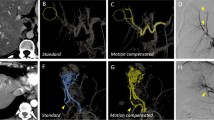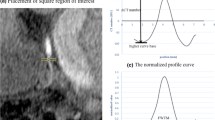Abstract
Objectives
To assess the impact of recently developed respiratory motion correction software on contrast-enhanced cone beam CT angiography (CBCT-a) for intraprocedural image guidance during intra-arterial liver-directed therapy.
Methods
From 2015 to 2017, two groups of patients who underwent intra-arterial liver-directed therapy with (breathing, n = 30) or without (still, n = 30) significant respiratory motion artifacts were retrospectively included. All CBCT-a were processed with and without dedicated respiratory motion correction software. Four readers independently assessed the following in both reconstructions (motion correction ON and OFF): (1) overall image quality on a 0-to-5 point scale, and (2) presence of relevant peri-procedural information on tumor and vasculature (overall vessel geometry, visibility of extrahepatic vessels, target tumor conspicuity, visibility of tumor feeders).
Results
Motion correction increased the average image quality in the breathing group from 2.0 ± 0.9 to 2.9 ± 1.0 (p < 0.01). The visibility of vessel geometry, extrahepatic vessels, and tumor feeders was significantly improved for all readers, and tumor conspicuity was improved for three readers. The average image quality was not significantly different between reconstructions in the still group (motion correction ON and OFF), for any of the readers (4.0 ± 0.6 vs 4.2 ± 0.6; p = 0.12). There was no change in the visibility of vessel geometry, extrahepatic vessels, tumor feeders, or tumor conspicuity for the four readers using the respiratory motion correction software in this group.
Conclusions
Using the dedicated respiratory motion correction software during intra-arterial liver-directed procedures increases the visualization of relevant peri-procedural information and image quality in CBCT-a corrupted by respiratory motion artifacts without affecting these elements in still CBCT-a.
Key Points
• The use of respiratory motion correction software could reduce the need for cone beam CT angiography acquisition retake.
• Motion correction software significantly increases the visibility of vessel geometry, extrahepatic vessels, and tumor feeders, as well as tumor conspicuity in cone beam CT angiography corrupted by respiratory motion artifacts.
• The use of respiratory motion correction software on cone beam CT angiography uncorrupted by respiratory motion artifact does not result in decreased image quality.






Similar content being viewed by others
Abbreviations
- CBCT-a:
-
Cone beam computed tomography angiography
- DSA:
-
Digital subtraction angiography
- MIP:
-
Maximum intensity projection
- SIRT:
-
Selective internal radiotherapy
- TACE:
-
Trans-arterial chemoembolization
References
Raj S, Irani FG, Tay KH, Tan BS (2013) C-arm cone beam computed tomography: a new tool in the interventional suite. Ann Acad Med Singapore 42:585–592
Tacher V, Radaelli A, Lin M, Geschwind JF (2015) How I do it: cone-beam CT during transarterial chemoembolization for liver cancer. Radiology 274:320–334. https://doi.org/10.1148/radiol.14131925
Minami Y, Yagyu Y, Murakami T, Kudo M (2014) Tracking navigation imaging of transcatheter arterial chemoembolization for hepatocellular carcinoma using three-dimensional cone-beam CT angiography. Liver Cancer 3:53–61. https://doi.org/10.1159/000343858
Miyayama S, Yamashiro M, Hashimoto M et al (2013) Identification of small hepatocellular carcinoma and tumor-feeding branches with cone-beam CT guidance technology during transcatheter arterial chemoembolization. J Vasc Interv Radiol 24:501–508. https://doi.org/10.1016/j.jvir.2012.12.022
Iwazawa J, Ohue S, Mitani T et al (2009) Identifying feeding arteries during TACE of hepatic tumors: comparison of C-arm CT and digital subtraction angiography. AJR Am J Roentgenol 192:1057–1063. https://doi.org/10.2214/AJR.08.1285
Pung L, Ahmad M, Mueller K et al (2017) The role of cone-beam CT in transcatheter arterial chemoembolization for hepatocellular carcinoma: a systematic review and meta-analysis. J Vasc Interv Radiol 28:334–341. https://doi.org/10.1016/j.jvir.2016.11.037
Lee IJ, Chung JW, Yin YH et al (2014) Cone-beam CT hepatic arteriography in chemoembolization for hepatocellular carcinoma: angiographic image quality and its determining factors. J Vasc Interv Radiol 25:1369–1379; quiz 1379-.e1. https://doi.org/10.1016/j.jvir.2014.04.011
Jonczyk M, Collettini F, Geisel D et al (2018) Radiation exposure during TACE procedures using additional cone-beam CT (CBCT) for guidance: safety and precautions. Acta Radiol 59:1277–1284. https://doi.org/10.1177/0284185118761203
Kothary N, Abdelmaksoud MH, Tognolini A et al (2011) Imaging guidance with C-arm CT: prospective evaluation of its impact on patient radiation exposure during transhepatic arterial chemoembolization. J Vasc Interv Radiol 22:1535–1543. https://doi.org/10.1016/j.jvir.2011.07.008
de Baere T, Arai Y, Lencioni R et al (2016) Treatment of liver tumors with lipiodol TACE: technical recommendations from experts opinion. Cardiovasc Intervent Radiol 39:334–343. https://doi.org/10.1007/s00270-015-1208-y
Gaba RC, Lokken RP, Hickey RM et al (2017) Quality improvement guidelines for transarterial chemoembolization and embolization of hepatic malignancy. J Vasc Interv Radiol 28:1210–1223.e3. https://doi.org/10.1016/j.jvir.2017.04.025
Tognolini A, Louie JD, Hwang GL, Hofmann LV, Sze DY, Kothary N (2010) Utility of C-arm CT in patients with hepatocellular carcinoma undergoing transhepatic arterial chemoembolization. J Vasc Interv Radiol 21:339–347. https://doi.org/10.1016/j.jvir.2009.11.007
Kim H-C (2015) Role of C-arm cone-beam CT in chemoembolization for hepatocellular carcinoma. Korean J Radiol 16:114–124. https://doi.org/10.3348/kjr.2015.16.1.114
Klugmann A, Bier B, Müller K, Maier A, Unberath M (2018) Deformable respiratory motion correction for hepatic rotational angiography. Comput Med Imaging Graph 66:82–89. https://doi.org/10.1016/j.compmedimag.2018.03.003
Sindel A, Bögel M, Maier A, Fahrig R, Hornegger J, Dörfler A (2015) Respiratory motion compensation for C-arm CT liver imaging. In: Handels H, Deserno TM, Meinzer HP, Tolxdorff T (eds) Bildverarbeitung für die Medizin 2015. Springer Berlin Heidelberg, Berlin, Heidelberg, pp 221–226
Acknowledgments
The authors would like to thank Yves Trousset for his help on this study.
Funding
This work is part of the HECAM (HEpatocellular CArcinoma Multi-technological) consortium project and received an institutional grant from “bpifrance.”
Author information
Authors and Affiliations
Corresponding author
Ethics declarations
Guarantor
The scientific guarantor of this publication is Marco Dioguardi Burgio.
Conflict of interest
The authors of this manuscript declare no relationships with any companies, whose products or services may be related to the subject matter of the article.
Statistics and biometry
One of the authors has significant statistical expertise.
No complex statistical methods were necessary for this paper.
Informed consent
Written informed consent was waived by the Institutional Review Board.
Ethical approval
Institutional Review Board approval was obtained.
Methodology
• retrospective
• observational
• performed at one institution
Additional information
Publisher’s note
Springer Nature remains neutral with regard to jurisdictional claims in published maps and institutional affiliations.
Electronic supplementary material
ESM 1
(DOCX 25465 kb)
Rights and permissions
About this article
Cite this article
Dioguardi Burgio, M., Benseghir, T., Roche, V. et al. Clinical impact of a new cone beam CT angiography respiratory motion artifact reduction algorithm during hepatic intra-arterial interventions. Eur Radiol 30, 163–174 (2020). https://doi.org/10.1007/s00330-019-06355-w
Received:
Revised:
Accepted:
Published:
Issue Date:
DOI: https://doi.org/10.1007/s00330-019-06355-w




